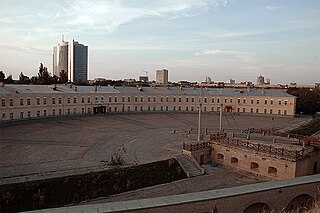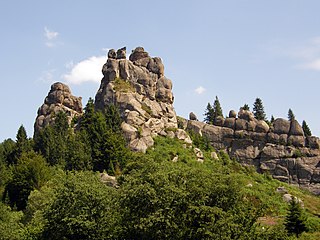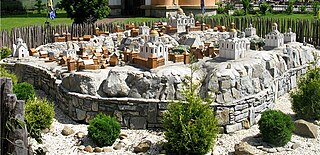
The Kyiv Fortress or Kiev Fortress is a historical and architectural monument complex of Russian fortifications in Kyiv, Ukraine built from the 17th through 19th centuries. Construction began after the 1654 Council in Pereiaslav, on the site of the already existing fortified monastery of Kyiv Pechersk Lavra. Located on the hills of the high right bank of the Dnieper, bounded on the north by the Klovsky ravine, on the south and west – by the slopes of the Lybid River valley.

Zmiiv or Zmiyiv from 1976 to 1990, is a city in Chuhuiv Raion, Kharkiv, Ukraine. It hosts the administration of Zmiiv urban hromada, one of the hromadas of Ukraine. The population in 2001 was 17,063, falling to 13,737.

The Defense of the Adzhimushkay quarry took place during World War II, between May and October 1942, in the Adzhimushkay quarry named after the Adzhimushkay suburb of Kerch during Nazi Germany's occupation of Crimea.

The Church of the Saviour at Berestove is a church located immediately north of Kyiv Pechersk Lavra in an area known as Berestove. Although it is situated outside the Lavra fortifications, the Saviour Church is part of the Lavra complex and the related World Heritage Site.

The Marc Chagall Museum is a museum dedicated to the painter Marc Chagall, in his hometown of Vitebsk, Belarus. The museum was founded by the Vitebsk City Executive Committee's decision on October 23, 1991.

Nikōnion and Nikōnia was an ancient Greek city on the east bank of the Dniester estuary. Its ruins are located 300 meters to the northwest of the modern village Roksolany, in the Ovidiopol district of the Odesa Oblast, Ukraine.

The Odesa Archaeological Museum is one of the oldest archaeological museums in Ukraine. It was founded in 1825; the current museum building was completed in 1883 according to a design by Polish architect Feliks Gąsiorowski.
Alexei Afanasyevich Kokel was a Chuvash painter who rose to prominence in Russia and Ukraine during the pre-Soviet and Soviet eras.

Khotiv hillfort is a hillfort of early Iron Age in the village of Khotiv, Ukraine.

Tustan was a Medieval cliff-side fortress-city and customs site of the 9th—16th centuries, an Old Rus' cliff-side defensive complex. Its remains are located in the Ukrainian Carpathians, in the Skole district of the Lviv Oblast, near the village of Urych, southwards from the town of Boryslav and to the southern-east from the village of Skhidnytsia. The unique monument of history, archeology, architecture, and nature is situated amidst the woods of Pidhorodtsi Forestry and is part of the Tustan Site Museum.

Tanais Archaeological Reserve Museum, or the Archaeological Museum-reserve Tanais, is one of the largest historical and archaeological open-air reserve museum in Russia.

Mamai–Hora is the largest multicomplex burial mound of national importance in the Northern Black Sea region. It is located on the left bank of the Kakhovka Reservoir near the village of Velyka Znamianka in Vasylivka Raion, Zaporizhzhia Oblast.

Kochubeyevsky Park is a monument of landscape art of local significance in Baturyn, Nizhyn district, Chernihiv region, Ukraine. It is a part of the National Historical and Cultural Preserve "Hetman's Capital".
Kharkiv University History Museum is one of the first history museums created at a higher educational institution in Ukraine. It is located on the second floor of the main building of V. N. Karazin Kharkiv National University.

Rubizhne is a village in Chuhuiv Raion (district) in Kharkiv Oblast of eastern Ukraine, at about 47.1 kilometres (29.3 mi) northeast by east from the centre of Kharkiv city, on the right bank of the Siverskyi Donets river.

Mayatskoye, also known as Mayatskoe or Mayaki, is a gorodishche and historical settlement located in the Divnogorye museum-reserve area of Liskinsky District in Voronezh Oblast, Russia. Along with Verkhnii Saltiv, it gives its name to the Saltovo-Mayaki culture, which is the main archaeological culture of the Khazars. Mayatskoye is the northernmost site associated with the Khazars, and was probably near the frontier with Slavic tribes. It is also one of the best-preserved and best-studied Khazar sites.

Ancient Halych is the National Architecture-Historical Preserve located in the western Ukrainian settlements of Halych, Krylos, Shevchenkove, Bilshivtsi, and Zalukva. The site includes landmarks of 11th–17th centuries in ancient Halych and its surroundings. The reserve was created on 8 February 1994.

Lysaya Mountain, is a peak of the Zhiguli Mountains, located on the border of the city of Zhigulevsk, between the city and the Zhiguli Nature Reserve. It is a unique natural complex combining rich and diverse flora, as well as being a geological, geomorphological monument and a landmark associated with various historical events.

Nikolai Vasilyevich Pinegin was a Russian and Soviet writer, artist, Arctic explorer. He was a member of the expedition of G. Y. Sedov on the ship "St. Martyr Foka".

















